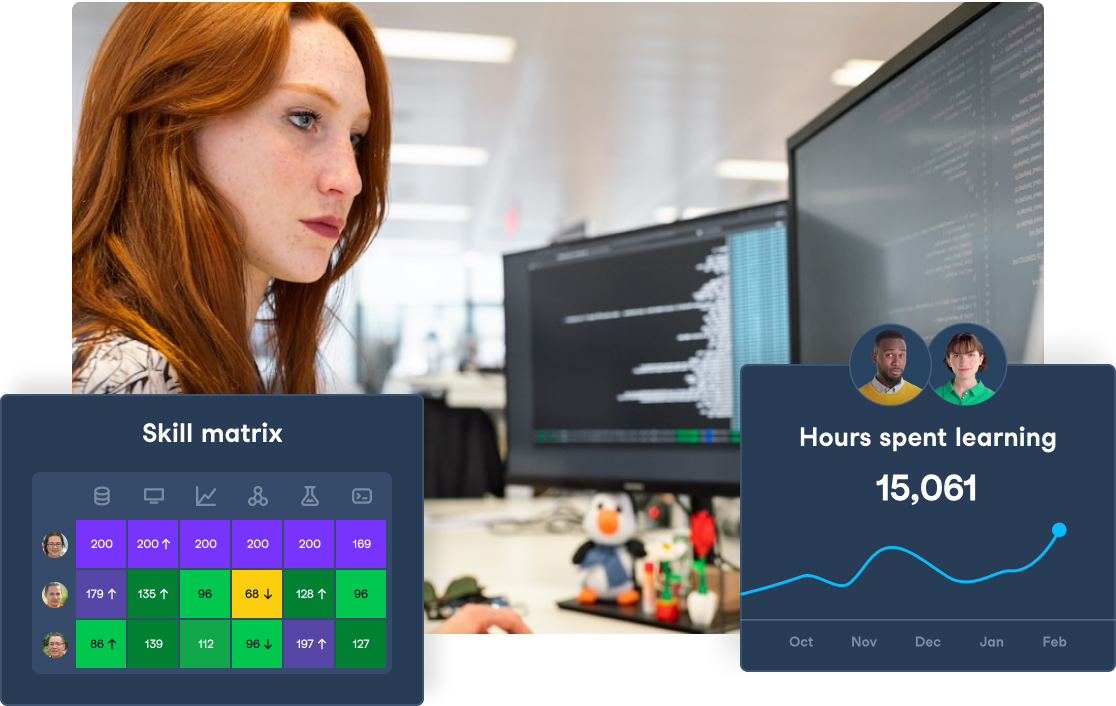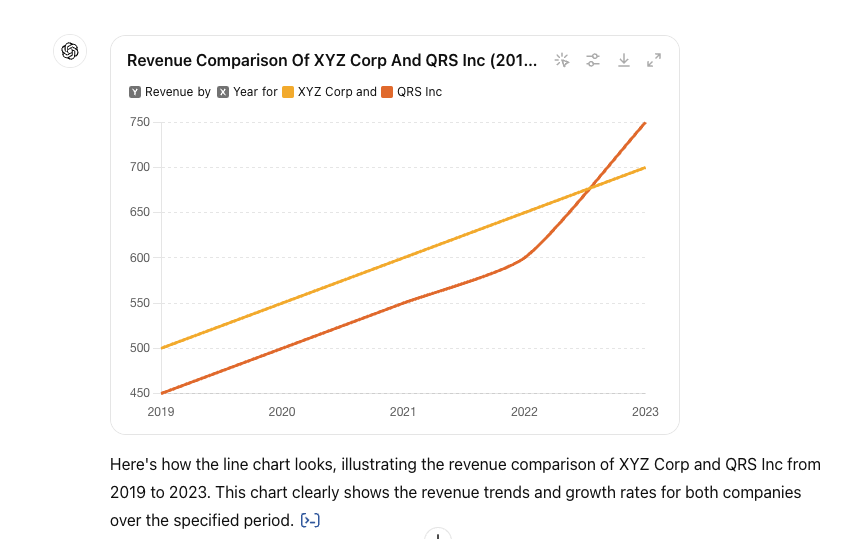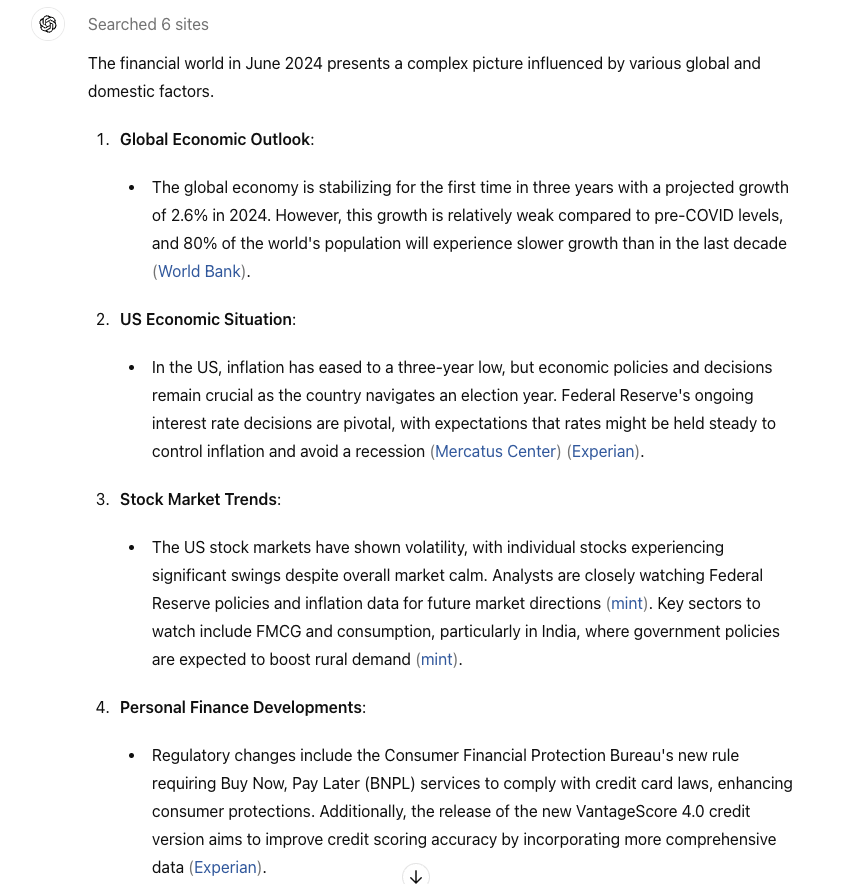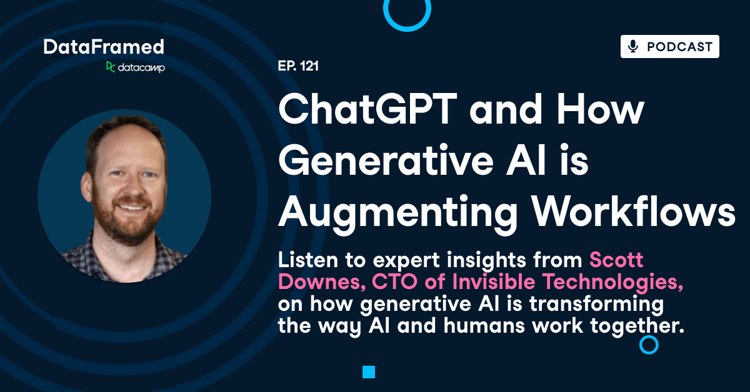Course
The advent of AI language models like ChatGPT by OpenAI is revolutionizing many sectors, including finance. These models are capable of generating human-like text to provide insights and can be utilized in a wide array of applications.
In this post, we explore ten ways you can use ChatGPT to enhance your financial operations and services, as well as how to implement ChatGPT into your business. You can also check out how AI is used in healthcare in a separate article. You can also view our webinar on ChatGPT & Generative AI: Boon or Bane for Data Democratization? to learn about the implications of using ChatGPT in your organization.
Elevate Your Finance Team's Data Skills
Train your finance team with DataCamp for Business. Comprehensive data and AI training resources and detailed performance insights to support your goals.

A Note on Using ChatGPT for Finance
If you’ve ever tried to use ChatGPT to get financial advice, you’ll have noticed that it gives some pretty non-committal responses. There’s good reason for this. The use of AI language models, such as ChatGPT, in the field of finance should be undertaken with due consideration. While these models can provide significant benefits in terms of efficiency and analytical capabilities, they should not replace human judgment or expertise in financial decision-making.
The output generated by these models is only as good as the data they are trained on, and they may not account for all factors influencing a financial situation. As such, the information generated by these models should always be reviewed and verified by financial professionals. Furthermore, it is important to ensure compliance with all applicable laws and regulations regarding data privacy and security when using these models.
With that in mind, let’s get started.
Recent Advancements in AI and Finance
Incorporated the latest updates
Recent advancements in AI have significantly enhanced the capabilities of models like ChatGPT. For instance, the introduction of GPT-4o has improved natural language understanding and generation, enabling more accurate financial analysis and insights. These updates allow for more sophisticated applications in finance, such as real-time risk assessment and automated compliance checks.
Case study: JP Morgan Chase
JPMorgan Chase's AI initiatives include the development of IndexGPT, an AI-powered financial assistant designed to enhance investment decision-making by processing vast amounts of financial data, detecting patterns, and generating actionable insights
The financial firm also has AI systems integrated with business intelligence tools and dashboards, allowing for real-time data analysis and improved decision-making processes across various financial services.
10 Ways to Use ChatGPT in Finance
As with many industries, ChatGPT and similar generative AI tools can save you time, make workflows more efficient, and complement your current role. However, it’s important to understand things like ChatGPT prompt engineering, which you can read about in a separate post.
To summarize, when creating ChatGPT prompts for finance, ensure you’re being clear, concise, and specific in your instructions, providing necessary context and links. You should also carry out iterative testing and refine your prompts to ensure the AI model generates the desired output.
Looking to get started with Generative AI?
Learn how to work with LLMs in Python right in your browser

1. Generating reports
One of the most time-consuming tasks in finance is report generation. With ChatGPT, you can automate this process to a degree. The AI tool can take structured data about your company's financial performance and produce a written summary detailing key points, trends, and observations. This function proves especially useful in producing regular reports such as quarterly earnings summaries.
Example prompt: I would like you to use the attached structured financial data to generate a detailed report. This report should include an analysis of key performance indicators, identification of trends, and observations about our company's financial performance over the last quarter.
2. Analyzing text data
Financial data is more than just numbers. Textual information, such as news articles, analyst reports, and social media posts, often holds valuable insights.
ChatGPT can analyze this text data and extract insights useful for financial decision-making. For example, it could gauge market sentiment about a particular company or sector, providing a more holistic view of the financial landscape.
Example prompt: I have a set of news articles and financial reports related to the tech industry. Can you analyze these texts and extract insights that indicate the overall market sentiment towards this sector?
3. Question answering
You can utilize ChatGPT to build a question-answering system for financial data. You might ask it questions like "What was the total revenue last quarter?" or "What is the trend in operating expenses?" and it can generate responses based on the data it has been trained on, providing quick and precise insights.
Example prompt: I have a dataset that includes financial data for ABC Corp. Based on this data, could you answer the following questions: What was the total revenue last quarter? Are there any observable trends in the operating expenses over the past year?
4. Interactive data analysis
The potential of ChatGPT goes beyond just answering questions—it can help create an interactive system for exploring financial data. You can ask it to perform specific analyses, request visualizations, or query about various metrics, and it will respond based on the data it has access to.

An example of using ChatGPT for financial analysis
Example prompt: I have financial data for two companies, XYZ Corp and QRS Inc. Could you perform an analysis that compares the revenue performance of these two companies over the last five years? Also, suggest some visualizations that would effectively illustrate this comparison.
5. Creating investment summaries
ChatGPT can digest a wealth of data on various investment options and generate concise, human-readable summaries. This application is particularly useful for financial advisors looking to provide clients with easily digestible information on potential investments.
Example prompt: I have data on several investment options, including stocks, bonds, and ETFs. Could you generate a brief, human-readable summary for each of these investments, highlighting key features and performance metrics?
6. Generating financial news briefs
By analyzing financial news, stock movements, market trends, and economic indicators, ChatGPT can generate briefs that offer quick insights into the financial world. This feature is especially valuable for traders and investors who need to stay updated with market conditions and changes.
Example prompt: Based on the latest financial news articles, stock market data, and economic indicators, can you generate a brief summary that provides insights into the current state of the financial world?

A ChatGPT Finance Prompt in Action
7. Automated customer interactions
ChatGPT's capabilities extend to building sophisticated chatbots capable of handling customer queries related to their financial data. In a banking scenario, customers could ask about their account balance, recent transactions, or credit card rewards, and receive instant, accurate responses.
Example prompt: Imagine you are a chatbot for a bank. How would you respond to a customer who asks the following questions: 'What is my current account balance?', 'Can you show me my recent transactions?' and 'How many reward points do I currently have on my credit card?'
8. Forecasting narratives
While ChatGPT itself doesn't perform predictive analytics, it can be used alongside predictive models to generate narratives around forecasted financial data. If a predictive model forecasts a company's sales for the next quarter, for example, ChatGPT could generate a narrative explaining the forecast in layman's terms, helping non-experts understand the implications.
Example prompt: I have a forecast from a predictive model indicating that sales for DEF Corp will increase by 10% next quarter. Could you generate a narrative that explains this forecast in layman's terms?
9. Translating financial jargon
The world of finance is filled with jargon that can be difficult for laypeople to understand. ChatGPT can translate complex financial terminology into plain language, making financial data more accessible to non-expert stakeholders or the general public and helping bridge the knowledge gap.
Example prompt: Could you explain the following financial terms in plain, easy-to-understand language: 'return on investment,' 'liquidity,' 'capital appreciation,' and 'diversification'?"
10. Training and simulation
ChatGPT's uses also extend to training scenarios. It can provide responses or generate scenarios based on financial data, proving particularly useful in training new analysts or simulating different financial situations for strategy development. It's like having a virtual coach that's available 24/7.
Example prompt: Could you generate a hypothetical scenario involving a sudden downturn in the stock market? Then, provide guidance on how a financial analyst might navigate this situation.
Implementing ChatGPT in Your Business: The Importance of Building Data Skills
Introducing ChatGPT into your business goes beyond merely adopting cutting-edge technology. To truly leverage its capabilities, you must equip your team with the right skills and strategies tailored to different roles within your organization. Here are four essential pillars to ensure a successful rollout of ChatGPT.
1. Provide proper training for different roles
The first step in implementing ChatGPT effectively is recognizing the diversity of users who will interact with the tool. Not everyone needs to be a developer, but everyone should be equipped to use ChatGPT according to their role.
- Developers: For those who will be working with the OpenAI API, in-depth training on API integration, prompt engineering, and handling AI outputs is essential. Developers should understand how to create and refine models that meet specific business needs.
- Casual Users: For non-technical users, training should focus on how to effectively use the ChatGPT interface for tasks such as report generation, data analysis, or customer support. These users should learn how to craft prompts that yield useful outputs and understand the limitations of AI responses. Our ChatGPT Fundamentals skill track and Business Use Cases of ChatGPT cheat sheet are the ideal resources here.
Tailoring training to the needs of different personas ensures that each group can maximize the benefits of ChatGPT, whether they’re coding sophisticated applications or simply using the chatbot for everyday tasks.
Deepen AI understanding
Embed AI Ethics at the Center of Your Training
AI ethics should be a core component of any training program. As ChatGPT becomes integrated into your business operations, it’s crucial to ensure that it’s used responsibly.
- Fairness and bias: Teach your team how to identify and mitigate bias in AI outputs. This includes understanding the sources of bias in training data and how to correct for it.
- Transparency and accountability: Ensure that all users, from developers to casual users, understand the importance of transparency in AI operations. They should know how to document AI processes and decisions, and who to hold accountable for AI-driven actions.
Embedding AI ethics into your training programs will help prevent misuse and build trust in the technology among your team and clients. Check out our separate post giving an introduction to AI ethics to learn more. You can also secure hands-on data and AI training for your finance team with DataCamp for Business.
Elevate Your Finance Team's Data Skills
Train your finance team with DataCamp for Business. Comprehensive data and AI training resources and detailed performance insights to support your goals.

Learn by doing
One of the most effective ways to integrate ChatGPT into your business is through hands-on experience. Encourage your team to engage in practical projects that allow them to apply their training in real-world scenarios.
- Pilot projects: Start with small, manageable projects that allow users to experiment with ChatGPT’s capabilities. This could include automating report generation or setting up a customer service chatbot.
- Iterative learning: As your team gains experience, encourage them to refine their approaches. Use the feedback from these projects to improve both the AI models and the team’s understanding of how to work with them.
Learning by doing not only builds confidence but also helps your team discover the most effective ways to use ChatGPT within your specific business context.
You might want to learn to work with the OpenAI API, allowing you to interact with ChatGPT and OpenAI’s other models. We also have a course on Developing AI Systems with the OpenAI API and a OpenAI API Cheat Sheet to act as a quick reference guide.
Stay updated
OpenAI has shown us that the pace of change in the AI field is rapid, and staying current is essential to maintaining a competitive edge.
- Continuous learning: Regularly update your training programs to include the latest developments in AI and data science. Encourage your team to participate in webinars, attend conferences, and engage with the AI community.
- Monitor AI advancements: Keep an eye on new features, updates, and best practices related to ChatGPT and other AI tools. Staying informed will allow your business to adapt quickly and continue to innovate.
By fostering a culture of continuous learning and staying up-to-date with the latest AI trends, you can ensure that your team remains at the forefront of AI technology and its applications.
Our Introduction to ChatGPT course covers the basics of the tool, and we continuously update the DataCamp and tutorials with the latest developments in the sector. Here are some to keep you current:
- Introduction to Embeddings with the OpenAI API course
- What is OpenAI's Sora?
- OpenAI Assistants API tutorial
- Building Chatbots with the OpenAI API and Pinecone code-along
- GPT-4o API tutorial
The implementation of ChatGPT
Once your team has a solid understanding of data handling and AI principles, you can begin planning the implementation of ChatGPT. Start by identifying specific areas in your business where ChatGPT could enhance efficiency or improve services, such as automating report generation or building a customer service chatbot.
Once you've identified a use case, you can train ChatGPT on relevant data and monitor its performance. Remember that the key to successful AI implementation is not just about technology—it's also about the people who use it. So, ensuring your team is equipped with the necessary skills is a critical first step.
Challenges and Solutions in Implementing ChatGPT in the Finance Industry
While implementing AI solutions like ChatGPT in your business can bring numerous benefits, it's also important to recognize and prepare for potential challenges. Here are some common hurdles you may encounter and strategies for overcoming them.
Data privacy and security
Challenge: Financial data is often sensitive, and using it to train an AI model like ChatGPT can raise privacy concerns. Additionally, ensuring the security of your data and AI systems is crucial to prevent breaches and maintain trust with your clients.
Solution: Implement robust data protection measures, including encryption, access controls, and regular security audits. When using AI, consider using techniques such as differential privacy to protect individual data points during training. Always ensure your use of data complies with relevant privacy regulations.
It's also worth bearing in mind that The European Union’s AI Act, enacted in 2024, introduces stringent guidelines for AI deployment in high-risk sectors like finance. Financial institutions must ensure their AI systems comply with these regulations to avoid hefty fines and ensure ethical usage.
Data quality and quantity
Challenge: AI models like ChatGPT require large amounts of high-quality data for training. Poor quality data or insufficient data can lead to inaccurate or biased results.
Solution: Establish rigorous data collection and preprocessing practices. This includes cleaning data, handling missing values, and ensuring the data is representative of the scenarios where the AI will be applied. It might also be worthwhile to explore partnerships or data-sharing agreements to access larger data sets.
Bias in AI responses
Challenge: AI models can sometimes replicate or amplify biases present in the training data, leading to unfair or inaccurate outcomes.
Solution: Implement regular audits of your AI's outputs to check for potential bias. You can also use techniques such as fairness-aware machine learning to mitigate bias in your AI model.
You can learn more about AI ethics in our separate post and learn how to use and develop artificial intelligence in a way that is fair, accountable, transparent, and respects human values.
Technical expertise
Challenge: Implementing AI solutions requires a certain level of technical expertise, which your team might not have initially.
Solution: Invest in training and development for your team. Online courses, workshops, and certifications can help your team develop the necessary skills.
Managing expectations
Challenge: AI is a powerful tool, but it's not a magic solution that can solve all problems. Unrealistic expectations can lead to disappointment and the perception that the AI project has failed.
Solution: Clear communication is key. Ensure all stakeholders have a realistic understanding of what AI can and cannot do. Set achievable goals, celebrate small wins, and view AI implementation as a journey rather than a destination.
Final Thoughts
ChatGPT is a versatile tool that can transform many aspects of the finance industry, from report generation to customer service. Its ability to analyze data, generate narratives, and interact with users in a natural, human-like manner makes it a powerful asset in the world of finance.
Implementing ChatGPT in your business is a journey that begins with learning and upskilling. By fostering a culture of continuous learning and staying updated with the latest advancements, you can ensure a successful and effective implementation of AI solutions like ChatGPT in your business.
By integrating AI like ChatGPT into your financial processes, you can enhance efficiency, improve customer experiences, and stay ahead in the rapidly evolving financial landscape. Get started with our ChatGPT Fundamentals skill track and explore DataCamp for Business to upskill your entire organization.
Elevate Your Organization's AI Skills
Transform your business by empowering your teams with advanced AI skills through DataCamp for Business. Achieve better insights and efficiency.


A senior editor in the AI and edtech space. Committed to exploring data and AI trends.
